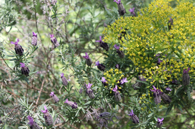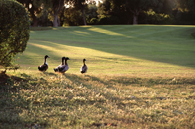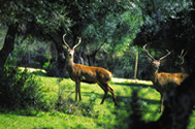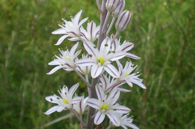ANIMALS AND PLANTS
This setting, offers tremendous scenic value and borders with the “Parque Natural de las Marismas de Barbate” to the south. As stated in the Council of Andalusia’s guide to natural parks: “these marshes represent a damp area of huge value to indigenous fauna, and occupy a privileged position on the western Atlantic migration routes, as a resting and recuperation area for species, which arrive to the coast of Cadiz exhausted following their journey from central and northern Europe or the African continent”.
For this reason, towards the end of summer and at the beginning of spring, visitors can be greeted by groups of up to a thousand storks (Ciconia ciconia and Ciconia nigra), flamingos, (Phoenicopterus roseus), bee-eaters and other birds which fly over the Dehesa de Montenmedio during their migration.
Some of the birds, characteristic to these parts are easily spotted along the route through the forest, home to the sculpture trail. Among the most common are the woodpigeon (Columba palumbus), dove, (Streptopelia decaocto) and stork (Ciconia ciconia), which have a number of nests within the estate. The partridge (Alectoris rufa) and pheasant (Chrysolophus pictus) are particularly common in spring and autumn, the former stands out as it moves in groups of up to 20, and in spring crosses paths with its young, while the latter usually appears alone among the brushes. Both are easily identifiable as low flying birds, covering short distances with strong wing movement. The common egret (Egretta garzetta), the swamphen (Porphyrio porphyrio) and the hoopoe, frequent the area around the pond where the sculpture “Fountain” is located, while also inhabiting the zone which borders on the golf course, surrounding part of the foundation. It is also not unusual to see a stork cooling off in this area.
In spring one can also easily identify the song of the blue tit (Parus caeruleus), great tit (Parus major) and blackcaps (Sylvia atricapilla), especially in the bushy, oak filled area which provides the route to the sculptures “Incense and Myrrh” in the most isolated, tranquil part of the forest. The common chiffchaff (Phylloscopus collybita), with its characteristic song can also be heard in autumn.
If the visit takes pace at dusk, the song of the birds gives way to the night sounds of the tawny owl (Strix aluco) which floods the forest. Blackbirds (Turdus merula) can be heard during the long summer afternoons. If one is fortunate and pays great attention they could see a sole eagle owl (Bubo bubo) which inhabits the quarry where the work Human Nests is found. When the owl takes flight between the brushes, one can observe the jackdaws (Corvus monedula), which continuously circle the quarry fleeing with their flock amid their characteristics squawks.
The Montenmedio Contemporary Foundation is situated on some 30 hectares, comprised of a Mediterranean pine grove predominantly occupied by the stone pine trees (Pinus pinea), in addition to the following species: Olive, (Olea Europaea sylvestris), Juniper (Juniperus phoenicea turbinata), Mastic(Pistacia lentiscos), Holm Oak (Quercus rotundifolia) and Cork trees.
There is also an abundance of aromatic and medicinal plants such as lavender (Lavandula stoechas), rosemary(Rosmarinus officinalis), thyme, (Thymbra capitata), rue, (Ruda graveolens), mandrake, (Mandrágora officinarum), butcher’s broom, (Ruscus aculeatus) and cactus (Opuntia ficus-indica), among others.
Nevertheless, the most curious animal of the forest is the myzomela (Herpestes ichneumon), an indigenous species very similar to the mongoose which is characterised for leading its young in single file, conferring on it the name of “furry snake”. The myzomela tends to make a nest on the ground, among the branches of the leafiest bushes.










